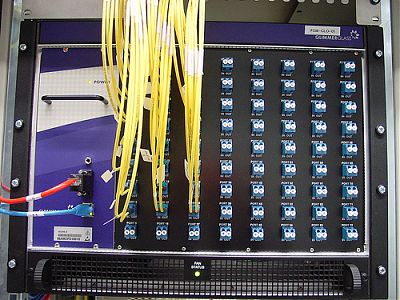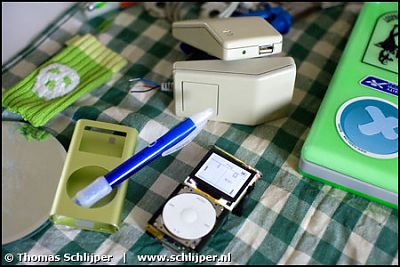...and then what?
Well, every once in a while I’m so in the middle of a lot of stuff, only at a moment like today I realize there’s not much to post, cause nothing is near finishing right now…
Actually, I’m really trying to make my big obsolete computer laboratory into a workable environment. To get to that point I did cheat a little, I’ve putten my old iBook upstairs (but hey, that’s obsolete in every sense… but it’s also the quickest machine in that room…) and now I use that there also, for googling and watching pdf-files in getting all the information to get the other systems going. If I can spend a few hours there every once in a while, at some point I should be getting there.

well, the Indigo2 works!
click to enlarge
Next to that, there’s plenty of stuff which happened lately and I barely blogged or didn’t blog at all (sometimes I consider putting a vague picture on my flickr with an even more vague description (if any) already blogging, but of course, that isn’t…)
Last wednesday I’ve been to AMS-IX. Now I know I said that, but just take a look at this machine alone.

click to go to the corresponding pic on flickr
It’s a glimmerglass intelligent optical switch and if I’m right, all the traffic from the AMS-IX, which happens to be the busiest internet exchange in the world, is going through that switch. (There’s a second one on another location btw.) Now think about that for a second. To me, it’s almost incomprehensible how much data that is. In numbers it’s about 250 gigabits/second tops (which they reach almost every day), but imagine the amount of people, the amount of machines, the amount of everything connected and which output is actually going through those lines… Well, any way, I was impressed… ^_^
Next, (something which I also already put on my flickr), as it turns out, a little piece about me ended up in something called the Amsterdam Index 2007, the pics which I made in the bookstore can be found here. In the end, I bought that copy, I’m not that cheap, you know?
yeah yeah yeah, I got my own copy ^_^
click to enlarge
Then, this afternoon I got a visit from a photographer, Thomas Schlijper, who came all the way from Amsterdam to take some pics of stuff I made, some of them including Bates and oh, myself. Some of these pics will be used in an article in a Dutch magazine, HCC!link. I enjoyed the session and I can’t wait to see the end result. For now, he put one (imho quite brilliant looking) picture up on his photoblog.

click to go to the corresponding picture on schlijper.nl
And for now, that’s about it! *^_^*
Message from Mark's family this site has been made static. This means that it will be no longer possible to comment on his ideas and projects, but that we all can continue to cherish his creativity.previous: ...and some gear which came home with me!
next: ...and then, nominated for a Dutch Bloggie?!?

 add to
add to 


“It’s a glimmerglass intelligent optical switch and if I’m right, all the traffic from the AMS-IX, which happens to be the busiest internet exchange in the world, is going through that switch.”
You are, unfortunately, wrong.
Only those networks that connect at 10gbit or more (True, for instance, has two 20gbit links) are connected to the glimmerglass photonic switches. Networks connecting at 1gbit and slower (i.e., most of them) are directly connected to an ethernet switch somewhere near it.
AMS-IX owns at least 7 of these beasts: two each at SARA, NIKHEF, Telecity2 and one more at GlobalSwitch. (I suppose because GS is less popular). They might also have another one in their lab, I don’t know.
What they do is connect you optically to an ethernet switch. In essence, they are automated patch panels: the switching happens at layer 1. They use these because using them, they can essentially connect you optically to two ethernet switches for redundancy. If the photonic switch notices the link going down (no more optical signal) it almost instantly connects you to the second switch. Your equipment will only notice this in a short link flap of about 20ms and some MAC-addresses being different.
> In essence, they are automated patch panels
Euhm, yeah, I asked a question about it and compared it to a real switch (as in, to turn on your lighting) and the answer was ‘yeah, it’s like a hotel-switch, only a very expensive one’...
So, yeah, the thing doesn’t do very much on an intelligent level actually, but still, there’s an awesome amount of data going through it.
BTW, are you sure the ‘less-than-10Gbit’-links take a different route? Cause I thought the whole genius of this setup was to be able to switch everything from one network to the redundant network and vice versa in a split second. What do they use to do that on the, for instance, 1Gbit-links and less?
They use VSRP for that, Virtual Switch Redundency Protocol, which is a way to connect all your switches to two core switches, one of which handles all the traffic, and the other one stepping in if the first craps out. The GE-connected customers are connected to an edge switch (or multiple if you want) which is connected to both core switches (in TC2 and NIKHEF). If your edge switch kills itself and you weren’t connected to a second one, you’re fucked.
Also, there are networks that connect to AMS-IX at 10 or 100mbit over copper, which of course won’t work well with the glimmerglass switches ;) GigE and above is only provided on fiber.
I think the reason those customers aren’t connected to glimmerglass switches is an economic one: 10gigE ports and those switches are ridiculously expensive, but gigE ports are cheap. Also AMS-IX has more than 250 networks connected to it, most of them now on gigE or faster and a lot of them with multiple ports. They’d need a lot more photonic switches to connect all their gigE customers this way. So it’s basically not worth it from an economic standpoint. This is what I think, at least.
Erm, I’m a little curious. Why’d you take apart your iPod? Battery borked? Or are you just showing it off? (iPod stripper. Heh.)
>Or are you just showing it off?
I took it apart because it was borked (a dead battery indeed), but I’m waiting with putting it back together because I have some plans with it first, so that’s why it’s in it’s current state (and it’s quite photogenic I guess, so that’s why it came on the picture)
(me showing off that I can take apart an iPod? I mean, geez man, what good would that be?)
For more information on AMS-IX, check out their website, www.ams-ix.net. They are very open about what they are doing and their performance. They show realtime traffic statistics and have a full discussion of their architecture.
As far as the Glimmerglass switches, the one shown is a medium sized switch. We have shipped switches with 160 ports, each capable of 40Gb/s, for a total of 6400 gigabits/sec through a non-blocking crossconnect (although most customers are only using 10Gb/s). Now that’s a lot of bandwidth.